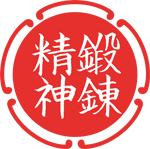Aunkai has a body approach rather than a technical approach of Bujutsu, and if most exercises are simply performed without any tool, alone or with a partner, a number of them still require weapons. This again will not be a kata-based weapon practice as it could be learnt in classical schools, but more of a use of traditional weapons as tools to condition the body.
In our Aunkai practice at the Seishin Tanren Dojo, three types of weapons are commonly used: the Rokushakubou, the Furibo and the Tambo. This first article will specifically be focusing on the use of the Rokushakubo, certainly the most widely used weapon in Aunkai.
The Rokushakubo
The 6 shaku Bo (more or less 6 feet long) is the most common weapon in Aunkai. Its use has been widely covered in a number of articles, interviews and videos and many exercises are developed in the DVDs. The recent article published by Filip Maric also covers the topic in a very complete and relevant fashion. If you did not read it yet, I invite you to do so.
The Bo allows to explore each of the Aunkai “work phases”:
- Solo training – Maho/Shiko/Tenchijin, Ashi Age, Shintaijuku, Tsuki
- Partner training – Walking Maho, Tsuki, etc.
- Applications and free work
The Bo has a number of strengths. First of all, being straight makes it the best tool to give feedbacks on alignments. It transmits forces in the clearest, straightest, most linear manner, which is extremely relevant in partner training as the Bo allows to see immediately the axes while preventing cheating. As an example, in Walking Maho, it will be very easy to replace the contact of the hands by the Bo, vertically or horizontally depending on what we want to work on.
Another great strength of the Bo in my opinion is its weight. I personally used three different Bo since I started Aunkai six years ago: a 5 Shaku Bo, a Chinese bamboo staff, and a rokushakubo. The first one quickly became too light to my taste, same for the bamboo despite its 2m-length. If the goal is not, and should never be, to develop muscular power, the weight is essential in my opinion as it enables to fix our mistakes and to feel how the weight of the weapon (or of a partner by extension) goes into the body, a crucial element in Aunkai.
How does weight correct mistakes ? Simple. With a light weapon, one can do dozens or hundreds of repetitions of Tsuki with a very poor structure (shoulders disconnected is a classic) without really feeling a problem. With a heavier Bo, a lack in structure will be felt almost immediately, shoulders would become painful as they would start carrying the weight, and the problem would be easy to spot.
The second point I mentioned was taking the weight of the weapon inside the body. Useful to comprehend how to use the weapon in the most efficient manner using minimum force, but also to shift to partner training (that could be with or without a Bo by the way). When learning how to use the Bo, you learn how the weight of the Bo is going in and out of your body, if a partner is now grabbing the Bo and giving it movement, you will be able to fine tune this skill by learning how to feel the weight of both the Bo AND the partner.
Last, but clearly not least, a Bo doesn’t let you brace. In partner training, it is often easy to go back to our bad habits and start bracing when trying to throw our partner. On a stick, it becomes a different story as it becomes clear that the power doesn’t go through the stick, hence have very minimal impact on the partner. Realizing you are bracing on a piece of wood is often a great way to realize something is wrong…


One thought on “Weapons in Aunkai: Rokushakubo”
Comments are closed.